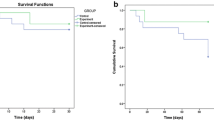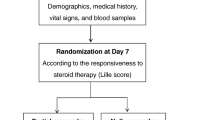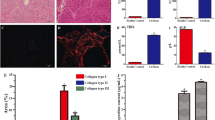Abstract
It has been shown recently that granulocytecolony-stimulating factor (G-CSF) accelerates andenhances the hepatocyte proliferative capacity ofpartially hepatectomized rats. In the present study, weinvestigated the effect of G-CSF administration in a ratmodel of liver injury and regeneration, induced bythioacetamide (TAA) injection. TAA (300 mg/kg bodyweight) was injected intraperitoneally in male Wistarrats, and this was followed by administration ofeither saline (group A) or G-CSF at a dose of 150μg/kg body weight (group B), 24 hr later. The animalswere killed at different time points after TAA treatment and the rate of tritiated thymidineincorporation into hepatic DNA, the activity of theenzyme thymidine kinase (EC 2.7.1.21) in the liver, andthe assessment of the mitotic index of hepatocytes, wereemployed to estimate liver regeneration. Theadministration of TAA caused severe hepatic injury,recognized histopathologically and by the raisedactivities of the serum hepatic enzymes aspartate andalanine aminotransferases. The hepatic injury, which peaked 36 hr afterTAA injection, was followed by a regenerative process ofhepatocytes presenting peaks at time points of 48 and 60hr (group A). The administration of G-CSF 24 hr after the injection of TAA (group B) causeda statistically significantly increase in the hepatocyteproliferation indices examined (P < 0.001), comparedto those found in group A at the same time points. It was concluded that G-CSFadministration enhanced the hepatocyte proliferativecapacity in this model of liver injury induced by TAAadministration.
Similar content being viewed by others
REFERENCES
Kirsch RE, Cohen CD, Saunders SJ, Van Hoorn-Hickman, Terblanche J, Alp M: Acute liver failure. In Liver and Biliary Disease, 3rd ed. R Wright, GH Millward-Sadler, KGM M Alberti, S Karran (eds). London, Bailliere Tindall/WB Saunders, 1985, pp 659–676
Fleig WE: Liver specific growth factors. Scand J Gastroenterol 23( suppl 151):31–36, 1988
Michalopoulos GK: Liver regeneration:molecular mechanisms of growth control. FASEB J 4:176–187, 1990
Michalopoulos GK, DeFrances MC: Liver regeneration. Science 276:60–66, 1997
Bergley C, Lopez A, Nicola N, Warren D, Vadas M, Sanderson C, Metcalf D: Purified colony-stimulating factors enhance the survival of human neutrophils and eosinophils in vitro: A rapid and sensitive microassay for colony-stimulating factors. Blood 68:162–166, 1986
Clark SC, Kamer R: The hematopoie tic colony-stimulating factors. Science 236:1229–1237, 1987
Ichinose Y, Hara N, Ohta M, Aso H, Chikama H, Kawasaki M, Kubota I, Shimizu T, Yagawa K: Recombinant granulocyte colony-stimulating factor and lipopolysaccharide maintain the phenotype of and superoxide anion generation by neutrophils. Infect Immun 58:1647–1652, 1990
Avalos B, Gasson J, Hedvat C, Quan S, Baldwin G, Weisbart R, Williams R, Golde D, DiPersio J: Human granulocyte colony-stimulating factor: biologic activities and receptor characterization on hematopoietic cells and small cell lung cancer cell lines. Blood 75:851–857, 1990
Goergen I, Hartung T, Leist M, Niehoerster M, Tiegs G, Uhlig S, Weitzel F, Wendel A: Granulocyte colony-stimulating factor treatment protects rodents against lipopolysaccharide-induced toxicity via suppression of systemic tumor necrosis factor-a. J Immunol 149:918–924, 1992
Fausto N, Laird AD, Webber EM: Role of growth factors and cytokines in hepatic regeneration. FASEB J 9:1527–1536, 1995
Diehl AM, Rai RM: Regulation of signal transduction during liver regeneration. FASEB J 10:215–227, 1996
Theocharis S, Margeli A, Goutas N, Horti M, Karkadaris C, Kittas C: G-CSF administration enhances hepatocyte regeneration after partial hepatectomy in rats. J Hepatol 23(suppl I):50, 1995
Theocharis SE, Agapitos E, Margeli AP, Goutas N, Kittas C, Davaris P: Effect of two forms of granulocyte-colonystimulating factor on hepatic regeneration after 70% partial hepatectomy in rats. Clin Sci 92:315–320, 1997
Margeli A, Theocharis S, Skaltsas S, Skopelitou A, Kittas C, Mykoniatis M, Varonos D: Effect of cadmium pretreatment on liver regeneration after partial hepatectomy in rats. Arch Toxicol 68:85–90, 1994
Margeli A, Theocharis S, Skaltsas S, Skopelitou A, Mykoniatis M: Effect of cadmium on rat liver regeneration after partial hepatectomy in rats. Environ Health Perspect 102( suppl 3):273–276, 1994
Theocharis S, Margeli A, Goutas N, Horti M, Karkadaris C, Kittas C: Granulocyte-colony stimulating factor administration reverses cadmium associated inhibition of hepatocyte regeneration. Eur J Gastroenterol Hepatol 8:805–809, 1996
Theocharis S, Margeli A, Kittas C, Delladetsima J: Granulocyte colony stimulating factor administration enhances hepatocytes regeneration in galactosamine-induced liver injury in rats. Hepatology 24(4Pt 2)P:467A, 1996
Fitzhugh OG, Nelson AA: Liver tumors in rats fedthiourea or thioacetamide. Science 108:626–628, 1948
Trennery PN, Waring RH: Early changes in thioacetamideinduced liver damage. Toxicol Lett 19:299–307, 1983
Chanda S, Mehendale HM: Role of nutritional fatty acid and L-carnitine in the final outcome of thioacetamide hepatotoxicity. FASEB J 8:1061–1068, 1994
Mangipudy RS, Chanda S, Mehendale HM: Tissue repair response as a function of dose in thioacetamide hepatotoxicity. Environ Health Perspect 103:260–267, 1995
Reddy J, Chiga M, Svoboda D: Initiation of the division cycle of rat hepatocytes following a single injection of thioacetamide. Lab Invest 20:405–411, 1969
Munro HN, Fleck A: Recent developments in the measure-ment of nucleic acids in biological materials. Analyst 91:78–88, 1966
Richards GM: Modifications of the diphenylamine reaction giving increased sensitivity and simplicity in the estimation of DNA. Anal Biochem 57:369–376, 1974
Kahn D, Svanas G, Eagon P, Makowka L, Podesta L, Chapchap P, Starzl T, Van Thiel D: Effect of an antiandrogenic H2 receptor antagonist on hepatic regeneration in rats. J Lab Clin Med 112:232–239, 1988
Lowry OH, Rosebrough NJ, Farr AL, Randall RJ: Protein measurement with the Folin phenol reagent. J Biol Chem 193:265–275, 1951
International Federation of Clinical Chemistry: Committee on Standards; Enzyme Panel. Clin Chem 24:720–721, 1978
Tsukamoto I, Kojo S: One evidence that thymidylate synthetase and thymidinekinase are the rate-determining enzymes of DNA biosynthesis in regenerating rat liver. Chem Lett 12:2313–2316, 1987
Porter WR, Gudzinowicz MJ, Neal RA: Thioace tamide-induced hepatic necrosis. II. Pharmacokinetics of thioacetamide and thioacetamide S-oxide in the rat. J Pharmacol Exp Ther 208:386–391, 1979
Kojima T, Sawada N, Zhong Y, Oyamada M, Mori M: Sequential changes in intercellular junctions between hepatocytes during the course of acute liver injury and restoration after thioace tamide treatment. Virchows Arch 425:407–412, 1994
Theocharis S, Margeli A, Karandrea D, Agapitos E, Kittas C: Immunohistochemical expression of metallothionein in the liver of thioace tamide intoxicated rats. Gut 41(suppl 3):A181, 1997
Cornell RP: Acute phase responses after acute liver injury by partial hepatectomy in rats as indicators of cytokine release. Hepatology 11:923–931, 1990
Yamada Y, Kirillova I, Peschon JJ, Fausto N: Initiation of liver growth by tumor necrosis factor: Deficient liver regeneration in mice lacking type I tumor necrosis factor receptor. Proc Natl Acad Sci USA 94:1441–1446, 1997
Theocharis S, Margeli A, Skaltsas S, Kittas C: Effect of acute phase response induction by turpentine oil administration on hepatocyte regeneration after partial hepatectomy in the rat. Hepatol Res 7:188–196, 1997
Gauldie J, Northemann W, Fey GH: IL-6 functions as an exocrine hormone in inflammation: Hepatocytes undergoing acute-phase responses require exogenous IL-6. J Immunol 144:3804–3808, 1990
Kordula T, Rokita H, Koj A, Fiers W, Gauldie J, Baumann H: Effects of interleukin-6 and leukemia inhibiting factor on acute phase response and DNA synthesis in cultured rat hepatocytes. Lymphokine Cytokine Res 10:23–26, 1991
Matsunami H, Kawasaki S, Ichizone S, Hashikura Y, Ikegami T, Makuuchi M, Kawasaki H, Iwanaka T, Nose A, Takamura M: Serial change s of h-HGF and IL-6 in living-related donor liver transplantation with special reference to their relationship to intraoperative portal blood flow. Transplant Proc 24:1971–1972, 1992
Cressman DE, Greenbaum LE, DeAngelis RA, Ciliberto G, Furth E, Poli V, Taub R: Liver failure and defective hepatocyte regeneration in interleukin-6–deficient mice. Science 274:1379–1383, 1996
Akira S, Hirano T, Taga T, Kishimoto T: Biology of multifunctional cytokines: IL-6 and related molecule s (IL-1 and TNF). FASEB J 4:2860–2867, 1990
Theocharis S, Margeli A, Goutas N, Horti M, Skaltsas S, Kittas C: Granulocyte colony stimulating factor administration enhances hepatocytes regeneration after partial hepatectomy in rats. Hepatology 22:499A, 1995
Rights and permissions
About this article
Cite this article
Theocharis, S.E., Margeli, A.P. & Kittas, C.N. Effect of Granulocyte Colony-Stimulating-Factor Administration on Tissue Regeneration Due to Thioacetamide-Induced Liver Injury in Rats. Dig Dis Sci 44, 1990–1996 (1999). https://doi.org/10.1023/A:1026657931829
Issue Date:
DOI: https://doi.org/10.1023/A:1026657931829




